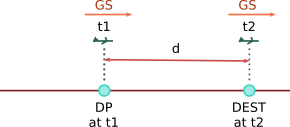How does GS determine the time interval it takes for an aircraft to fly from the DP to the DEST, if TAS determines how the fast the aircraft is really going through the air.
The simple answer to this question is when you calculate the time to fly from DP to DEST you need to use distance and velocity t = d/v. But d and v need to be referenced to the same frame of reference.
- DP and DEST locations are referenced to the ground frame.
- The distance d is therefore computed in the ground frame.
- v must be expressed in the ground frame, this is GS.

Computation of d in the ground frame
This is really simple but you need to know GS. If you know TAS and wind velocity, then the next method can be used.
While d and v must be in the same frame, this frame could be the air mass frame as well:
TAS is aircraft velocity measured relatively to the air mass frame.
To compute d in the air mass frame you would need to take into account that DP and DEST are moving relatively to the air mass frame due to the wind.
The distance d to cover is not the distance on the ground, but the distance between points in the air mass which coincide with the verticals of DP and DEST at the time the aircraft reaches these air mass points.

Computation of d in the air mass frame
Therefore to determine d you would need to take into account the air mass velocity relative to the ground, that is the wind velocity (more accurately the wind velocity vector projected on the flight path).
This time you need to know both TAS and wind velocity.
My current guess is that GS accounts for the wind
As you infer correctly there is no mystery when using GS, GS is the sum of TAS and wind:

GS is related to TAS via wind velocity
So if you're lucky enough to know GS and use the ground frame, which is more simple, to compute the trip time, it's because someone or a tool already did the sum.
The third reference frame, the aircraft frame, could be used as well, d and v would need to be expressed in this frame. "I let the reader do the exercise" :-)



